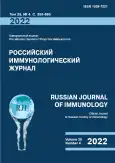Ассоциация изменений цитокинового профиля и компонентов метаболического синдрома у пациентов молодого возраста
- Авторы: Сумеркина В.А.1, Телешева Л.Ф.1, Головнева Е.С.1
-
Учреждения:
- ФГБОУ ВО «Южно-Уральский государственный медицинский университет»
- Выпуск: Том 25, № 4 (2022)
- Страницы: 535-540
- Раздел: КРАТКИЕ СООБЩЕНИЯ
- URL: https://journals.rcsi.science/1028-7221/article/view/120139
- DOI: https://doi.org/10.46235/1028-7221-1164-AOT
- ID: 120139
Цитировать
Полный текст
Аннотация
Компоненты метаболического синдрома (МС) являются независимыми факторами кардиометаболического риска и ассоциированы с нарушениями гуморального иммунитета, однако литературные данные об особенностях цитокинового профиля при МС неоднозначны. Выполнено определение уровня цитокинов у пациентов обоего пола с МС и исследована их взаимосвязь с компонентами МС, а также показателями, характеризующими функцию висцеральной жировой ткани. В работу включили 149 пациентов в возрасте 18-45 лет. Пациентов распределили в 2 группы: 1-я группа (n = 71) – пациенты без абдоминального ожирения и компонентов МС (группа сравнения); 2-я группа (n = 78) – пациенты с МС. Определяли концентрацию глюкозы, гликозилированного гемоглобина, инсулина, общего холестерина, ХсЛПВП, ХсЛПНП, триглицеридов, лептина, адипонектина; рассчитывали индексы инсулинорезистентности HOMA-IR, Тг/ЛПВП и TyG, а также маркер дисфункции висцеральной жировой ткани VAI. Методом ИФА определяли концентрацию IL-1β, IL-2, IL-4, IL-6, IL-8, IL-10, IFNα, IFNγ, МСР-1 и TNFα.
У пациентов с МС было определено повышение уровня IL-6, IL-10, МСР-1 и снижение цитокинов IL-2, IL-4, IFNγ. Методом корреляционного анализа установлена взаимосвязь уровня глюкозы и МСР-1; гликозилированного гемоглобина и IL-6, TNFα. Среди показателей липидного обмена установлена ассоциация ХсЛПНП и IFNγ; ХсЛПВП и IL-2, IL-4, IFNγ. Уровень триглицеридов был взаимосвязан с МСР-1. Установлена отрицательная взаимосвязь наличия артериальной гипертензии и содержания IL-4. Также была определена отрицательная корреляция уровня лептина с концентрацией IL-4 и IFNγ. Показатели, характеризующие инсулинорезистентность Тг/ЛПВП и TyG, были ассоциированы с поддерживающим хронический воспалительный процесс хемокином МСР-1. Индекс VAI, отражающий дисфункцию висцеральной жировой ткани, был взаимосвязан с МСР-1.
Таким образом, полученные результаты свидетельствуют об участии системы цитокинов в формировании патологии висцеральной жировой ткани и развитии метаболического синдрома.
Полный текст
Открыть статью на сайте журналаОб авторах
В. А. Сумеркина
ФГБОУ ВО «Южно-Уральский государственный медицинский университет»
Автор, ответственный за переписку.
Email: veronika.sumerkina@mail.ru
к.м.н., ведущий научный сотрудник ЦНИЛ
Россия, ЧелябинскЛ. Ф. Телешева
ФГБОУ ВО «Южно-Уральский государственный медицинский университет»
Email: veronika.sumerkina@mail.ru
д.м.н., профессор кафедры микробиологии, вирусологии и иммунологии
Россия, ЧелябинскЕ. С. Головнева
ФГБОУ ВО «Южно-Уральский государственный медицинский университет»
Email: veronika.sumerkina@mail.ru
д.м.н., профессор кафедры нормальной физиологии имени академика Ю.М. Захарова
Россия, ЧелябинскСписок литературы
- Blaszczak A.M., Jalilvand A., Hsueh W.A. Adipocytes, innate immunity and obesity: a mini-review. Front. Immunol., 2021, Vol. 12, 650768. doi: 10.3389/fimmu.2021.650768.
- Braune J., Weyer U., Hobusch C., Mauer J., Brüning J.C., Bechmann I., Gericke M. IL-6 regulates M2 polarization and local proliferation of adipose tissue macrophages in obesity. J. Immunol., 2017, Vol. 198, no. 7, pp. 2937-2934.
- Dommel S., Blüher. M. Does C-C motif Chemokine Ligand 2 (CCL2) link obesity to a pro-inflammatory state? Int. J. Mol. Sci., 2021, Vol. 22, no. 3, 1500. doi: 10.3390/ijms22031500.
- Formanowicz D., Rybarczyk A., Radom M., Formanowicz Р. A role of inflammation and immunity in essential hypertension — modeled and analyzed using Petri nets. Int. J. Mol. Sci., 2020, Vol. 21, no. 9, 3348. doi: 10.3390/ijms21093348.
- Fu S., Yao Y., Lv F., Zhang F., Zhao Y., Luan F. Associations of immunological factors with metabolic syndrome and its characteristic elements in Chinese centenarians. J. Transl. Med., 2018, Vol. 16, 315. doi: 10.1186/s12967-018-1691-4.
- Hammarstedt A., Gogg S., Hedjazifar S., Nerstedt A., Smith U. Impaired adipogenesis and dysfunctional adipose tissue in human hypertrophic obesity. Physiol. Rev., 2018, Vol. 98, no. 4, pp. 1911-1941.
- Hubler M.J., Kennedy A.J. Role of lipids in the metabolism and activation of immune cells. J. Nutr. Biochem., 2016, Vol. 34, pp. 1-7.
- Janowska J., Chudek J., Olszanecka–Glinianowicz M., Semik-Grabarczyk E., Zahorska-Markiewicz B. Interdependencies among selected pro-inflammatory markers of endothelial dysfunction, C-peptide, anti-inflammatory interleukin-10 and glucose metabolism disturbance in obese women. Int. J. Med. Sci., 2016, Vol. 13, no. 7, pp. 490-499.
- Kassem K.M., Ali M., Rhaleb N.-E. Interleukin 4: its role in hypertension, atherosclerosis, valvular, and nonvalvular cardiovascular diseases. J. Cardiovasc. Pharmacol. Ther., 2020, Vol. 25, no. 1, pp. 7-14.
- Lin S.-Y., Yang C.-P., Wang Y.-Y., Hsiao C.-W., Chen W.-Y., Liao S.-L., Lo Y.-L., Chang Y.-H., Hong C.-J., Chen C.-J. Interleukin-4 improves metabolic abnormalities in leptin-deficient and high-fat diet mice. Int. J. Mol. Sci., 2020, Vol. 21, 4451. doi: 10.3390/ijms21124451.
- Liu N., Sheng J., Wang Y. Effect of stress hyperglycaemia on monocyte chemoattractant protein-1 levels and the short-term prognosis of patients with acute ST-segment elevation myocardial infarction undergoing primary percutaneous coronary intervention. Exp. Ther. Med., 2019, Vol. 17, no. 5, pp. 3823-3829.
- Monserrat-Mesquida M., Quetglas-Llabrés M., Capó X., Bouzas C., Mateos D., Pons A., Tur J.A., Sureda A. Metabolic syndrome is associated with oxidative stress and proinflammatory state. Аntioxidants, 2020, Vol. 9, no. 3, 236. doi: 10.3390/antiox9030236.
- Rodriguez-Iturbe B., Pons H., Johnson R.J. Role of the immune system in hypertension. Physiol. Rev., 2017, Vol. 97, no. 3, рр. 1127-1164.
- Rucker A.J., Crowley S.D. The role of macrophages in hypertension and its complications. Pflugers Arch., 2017, Vol. 469, no. 3-4, pp. 419-430.
- Zhuang Y., Zhang J., Li Y., Gu H., Zhao J., Sun Y., Wang R., Zhang C., Chen W., Weng J., Qi L., Lu H., Zhang J., Liu Q., He Y., Xu X. B lymphocytes are predictors of insulin resistance in women with gestational diabetes mellitus. Endocr. Metab. Immune Disord. Drug Targets, 2019, Vol. 19, no. 3, pp. 358-366.
Дополнительные файлы







